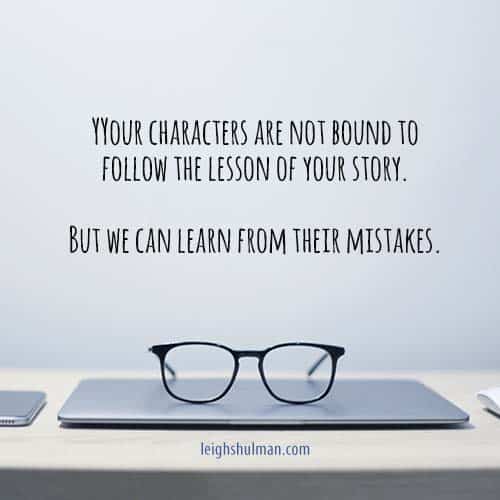When you know all about your characters, you can focus your writing on one main thread. It helps you wrangle the various pieces of your writing into one cohesive vision.
Themes.
Narrative.
Arc.
Character.
Scenes.
Structure.
This hack helps keep the different pieces of your writing on the same track. It applies to fiction and non-fiction, short stories and books. You can modify this hack to apply to all kinds of writing.
It’s a bit on the esoteric side, but I promise you, when you put your characters into the greater framework of your narrative, you naturally create a more cohesive mental image of your writing. That image stays with you as you write and allows you to take all these different pieces of your writing process into account as you write.
It starts with knowing what your story is about.
When I ask you what’s your story about, I don’t mean what’s the plot. I don’t mean the characters. I’m asking what you want your readers to understand and feel when they finish reading your writing.
Before you move onto the next step in this editing hack, write down your About in one sentence.
Examples of Abouts:
The Alchemist: We are all destined for something important (even if finding it takes a circuitous route)
The Book Thief: Words have incredible power to bring people together and hold us to our values.
Salt Sugar Fat: The food industry has long controlled our eating habits with these three substances.
Connect your characters to your story.
How do your characters embody the About of your story?
If you’re writing fiction, you know who your characters are. If you’re writing a memoir, the characters will be you and the people you include in the book. For non-fiction, you won’t address characters in the same way and instead will focus on the episodic information within the book.
Character examples that connect to your About:
The Alchemist: The main character, the shepherd boy, decides to be a shepherd in spite of his family wanting otherwise. The spot where he sits when he first tends sheep is the location of a treasure he finds once completed his journey.
The Book Thief: Liesl, a young girl living in Nazi Germany, learns to write from Max, a Jewish writer Liesl’s father hides during the war. Max instills a love of reading in her, so much so she sits in the basement to read while bombs drop on their city. Hiding to read literally saves her life.
As you can see, the ways a character connects with your About can be literal and metaphoric. Either way serves your writing.
A non-fictional example of how a character connects to your About:
Salt Sugar Fat: Michael Moss meets with and interviews the heads of fast food companies. One man opens a company selling carrots in his own way of doing penance for the harm his work caused while engineering food products that keep us addicted to buying and eating them. The book also discusses a secret meeting of fast food company representatives to discuss the state of the industry. They’re aware of the foods they create cause harm and choose not to change their actions.
Your characters are not bound to follow the lesson of your story.
But we can learn from their mistakes.
Your characters want other things. They do things that aren’t good for them. They act in ways that create tension and don’t always believe in your About. Your readers can learn from them what NOT to do. Sometimes these whacky characters go back to your lesson and learn from it. Sometimes they don’t and they suffer for it.
How you portray each character helps you refine and define the About.
When the shepherd boy in The Alchemist believes in himself enough to follow his dreams in spite of his father’s wishes, we watch him learn and grow until he returns to the same spot he began. When he began, he didn’t have the knowledge he needed to understand the physical treasure below him. He needed the spiritual and emotional of his journey to fully understand the value.
The shepherd boy fully invests himself in the About and his actions follow through accordingly.
The Englishman, a fellow traveler in the Alchemist, by contrast, wants to find a shortcut, a direct route to finding solutions. It is not a surprise The Englishman doesn’t find his treasure — spiritual or physical — via his books and learning.
Keeping track of all the threads of your story.
It’s a lot to maintain at once. Your characters, your About, themes, scenes, structure, oh, Lord what else?
When you write your About on paper, you become crystal clear. You know what your writing toward. You know what your writing means. That stays with you quietly as you write and guides you as you write scenes and finish drafts.
At some point in the writing process, take a step back and examine what you’ve written. Take a moment to see the connection between each character and the About. What drives the characters? How do they follow or deviate from your About?
The connection, as I said before, can be metaphoric or literal, and often your characters will lead you where you want to go.
Each scene you write is an opportunity to show how your characters embody the About of your book
Going back to the previous examples:
The Alchemist: The shepherd boy meets Fatima. He wants to be with her and her him, but he knows he has a journey ahead of him. Fatima. She tells him to go, because she, too, understands the fundamental understanding of the book. We all have a destiny. Fatima loves the shepherd boy and wants him to find his destiny, and she knows if the two of them are destined to be together, he will return. She tells him to go.
Salt Sugar Fat: Throughout the majority of the book, Michael Moss doesn’t outright tell us his opinion of the food industry, although the title suggests his belief when he says they food giants “hooked us.” Each anecdote he shares, though, shows another example of how the processed food industry manufactures their products, clears shelf space, prices and pushes out healthy food to make their salty, sugary, fatty foods a constant drip in our diets. Each example shows how they care about money to the exclusion of our health and well being.
As your characters act and change over the course of writing, you show your readers a new way to understand your About.


